Old Goa good place to start is the Quay of the Viceroys, now the jetty on the River Mandovi. This is an agreeable place where a hushed river swishes against weather-beaten stones. As one turns their back to the river the Arch of the Viceroys stands erect in front, rising above what was once the Rua Direita or the main access of the city. It is little more than a grimed track currently. One needs to use their vision to reconstruct the busy metropolis that once hustled, bought and merchandised by the river
The arch is created from laterite soil, excluding the facade, which is facetted with greenish granite. The niche on the top has a statue of Vasco da Gama. The arch has been reconstructed several times - the last time in 1599 by Francisco da Gama, in memory of his great-grandfather (that is one of the inscriptions; the other memorialises the liberation of Portugal from Spain in 1640). The statue of St. Catherine, which possesses its own recess, was then dismantled. The arch was reconstructed in black stone at the concluding period of 16th century on the orders of Vasco da Gama`s great-grandson.
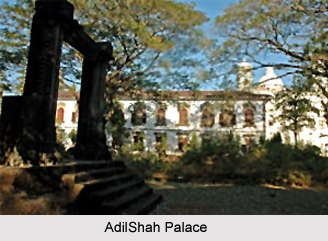 Close to the arch is what was once the palace of Adil Shah of Bijapur. All one can view now of the palace is its basalt gate. This was a multi-storey building that was the most prominent in the city until the Portuguese seized it. Used as the residence of the Portuguese governors and viceroys till 1695, it was destroyed in 1920 and the material was utilised to build homes in Panaji.
Close to the arch is what was once the palace of Adil Shah of Bijapur. All one can view now of the palace is its basalt gate. This was a multi-storey building that was the most prominent in the city until the Portuguese seized it. Used as the residence of the Portuguese governors and viceroys till 1695, it was destroyed in 1920 and the material was utilised to build homes in Panaji.
To the west of the gate is the Church of St. Cajetan. The convent attached to it is the Pius XI Institute, a pastoral college. The church was built by the isolated Theatine order of monks, and is modelled in a humble way on St. Peter`s in Rome. It has exquisitely carved and engilded woodwork, enormous old paintings, accomplished on canvas from cast-off sails of ships and a catacomb beneath the altar where the coffins of governors used to be stored, awaiting their passage to Portugal. The church has been regenerated by the ASI.
The frontage has two bell-towers and four recesses, which are the images of the apostles. The church is Corinthian in pattern, excluding the ornately carved engilded altars, which are in the Baroque style.
There are six carved and gilded Baroque altars besides the central one, which are dedicated to Our Lady of Divine Providence. The altars have paintings on canvas from the cast-off sails of ships, some portraying scenes from the life of St. Cajetan. These are in the style of the Italian schools of painting.
In the middle of the nave, immediately below the exquisite cupola that is raised over four large arches, is a tank or a well, which has been the focus of intense dispute. One theory has it that the platform covers a tirtha (holy tank) of a Hindu temple that may once have existed there, while others say the water reservoir at the centre of the building was created when the foundation was laid.
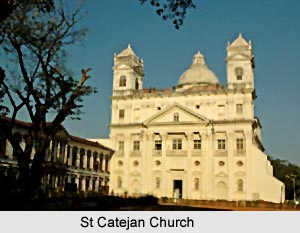 St. Cajetan church`s timings include from 9 a.m. - 5.30 p.m.
St. Cajetan church`s timings include from 9 a.m. - 5.30 p.m.
Farther up on the right is the outstanding Se Cathedral, Asia`s largest church, more than 250 ft in length, 180 ft wide and with a facade of 116 ft. It took almost 70 years (1562 to 1631; the altars were added in 1652) to erect this church and one understands why, as soon as one enters the threshold. The imposing proportions of the cathedral strikes one almost straightaway.
The cathedral has three porticos and three naves. On the top of the middle portico, sustained by Corinthian columns, is a huge slab with a diadem and keys. On the right side of the entryway is a chamber containing an octagonal baptismal font, dating back to 1532. This is believed to be the same font that St. Francis XI had utilised. Hung below the choir is a captivating painting of St. Christopher, donning a Goan dhoti and carrying the child Jesus across a river.
The chief altar is dedicated to St. Catherine of Alexandria, on whose feast day the Portuguese had seized Goa. The engilded panel depicts the martyrdom of the saint. On both sides is a niche in which wooden statues of St. Paul and St. Peter are preserved. Along the sides of the nave near the altar are wooden seats for canons and a throne for the archbishop. There is also an ornately carved ebony stand, originally from the Church of St. Francis D Assisi. The arches beautifying the side altars are ornamented with paintings portraying scenes from the lives of the saints.
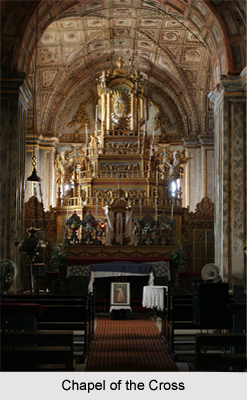 Along the sides of the central nave are eight chapels. Of specific note are the marvellously decorated Chapel of the Blessed Sacrament on the left as one enters, and the Chapel of the Cross of Miracles, on the right. It is advised to look for the beautiful punctured wooden screens with soft filigree carving.
Along the sides of the central nave are eight chapels. Of specific note are the marvellously decorated Chapel of the Blessed Sacrament on the left as one enters, and the Chapel of the Cross of Miracles, on the right. It is advised to look for the beautiful punctured wooden screens with soft filigree carving.
The interior walls of the cathedral were covered with paintings, which were later whitewashed. These are now being re-established. The standing bell tower houses the famous `golden bell`, distinguished by visitors for the opulence of its nature. Before the Inquisition was abolished in late 18th century, this golden bell was knelled, as the ghastly procession of the Auto da Fe left the cathedral for burning misbelievers alive. There was a tower on the other side of the cathedral too, but it was struck by lightning in 1776 and crumbled. If it is feasible, one can wait till night falls, when floodlights illumine the church.
Se Cathedral timings are from 7.30 a.m. - 6 p.m. daily. Tourists are however advised not to disturb the mass.
Adjoining the cathedral (a visitor can enter it from the church itself, through a door on the right) is the former Archbishop`s Palace (currently being reinstated by the ASI).
On the western side of the cathedral is the Church of St. Francis de Assisi, built of lime-plastered laterite blocks. The church, also known as the Church of the Holy Spirit, was built in 1520 by Franciscan Friars and reconstructed in 1663. All that persists of the original structure is the doorway, an exceptional specimen of Manueline architecture, integrating some of its best features like curved arches, armillary spheres, the Greek cross and carving. In a recess on the facade stands St. Michael, the Archangel. It has six chapels, one of which has a statue of Our Lady of Miracles that had arrived from Sri Lanka. On both sides of the altar are paintings picturing the life of Saint Francis.
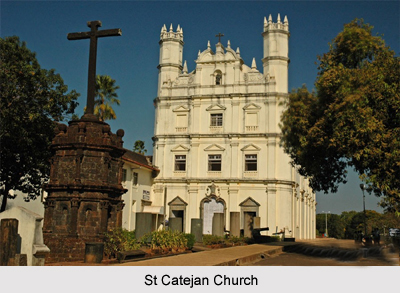 Church of St Francis de Assisi is open from 7.30 a.m. - 6.30 p.m.
Church of St Francis de Assisi is open from 7.30 a.m. - 6.30 p.m.
Adjacent to the church is the former convent of the Franciscans, which now houses the Archaeological Museum. Though the galleries of paintings are irksome, yet there is a magnificent altar and some grand statues of Vasco da Gama, Afonso de Albuquerque and some early Hindu carvings from Goa. Numismatists and philatelists might take pleasure in peering at the Estado da India stamps and coins.
The Archaeological Museum entry fee is Rs. 5 for every visitor. The timings are from 10 a.m. - 5 p.m. The museum remains closed on Fridays.
At the end of a tapered road around the corner is the modest Chapel of St. Catherine, constructed on the dilapidations of an earlier 16th century chapel. A stone slab on the outside engraved in Portuguese reads - "Here in this place was the doorway through which Governor Afonso de Albuquerque entered and took this city from the Mohammedans on the day of St. Catherine in the year 1510 in whose honour and memory the Governor George Cabral ordered this chapel to be built in the year 1550 at the expense of his Highness." (St Catherine Day falls on November 25.)
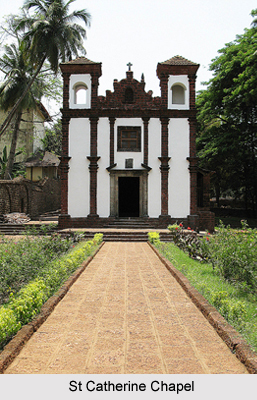 The chapel is open from 6 a.m. - 6 p.m.
The chapel is open from 6 a.m. - 6 p.m.
Across the National Highway from Se Cathedral is the most significant church in all of Goa - Basilica de Bom Jesus, home to the relics of St. Francis Xavier and a UNESCO World Heritage monument. The most adept example of baroque architecture in India, it can be identified straightaway, because the lime plaster has been removed and the red laterite of which it is built, radiates darkly in the sun. In the 1930s, the exterior was stripped of its original lime plaster by a Portuguese architect, who thought that the red laterite would be cured by exposure to the elements and would prevent water seeping into the structure during the monsoon. His experiment was highly unsuccessful and almost seven decades later, the ASI is still wrestling with the problem of water seepage, but the Basilica looks so outstandingly un-plastered that it has stayed that way since.
Modelled on Gesu, the mother church of the Jesuit Order in Rome, the three-storey facade has Ionic, Doric and Corinthian colonnades. Inside the church, there is a choir box, two chapels, a primary altar and a vestry. The belfry is at the back. A gallery meant for luminaries, runs along the two sides. At the affluent baroque altar, one can witness the Saint Ignatius of Loyola, founder of the order of the Jesuits, gazing enchanted at a medallion with the letters IHS, the first three letters of Jesus in Greek. There are two auxiliary altars on both sides - one dedicated to Saint Michael and the other to Our Lady of Hope. On the northern side of the transept is the Chapel of the Blessed Sacrament.
On the southern side is the chapel with engilded columns and flowers carved in wood, in which the relics of St. Francis lie. The walls of the chapel recount the story of the life of the saint. One can see him interviewing the king of Bango in Japan, meeting Portuguese nobles, kissing the wound of a Venetian patient as an act of humbleness and care, and Pope Paul III blessing him before he left for India.
The tomb itself, a gift from Medici, Cosimo III, the Grand Duke of Tuscany, was planned by Giovanni Battista Foggini (not exactly a gift though; he had given the tomb to Goa in return for the pillow of the saint). It has a base of red and purple jasper. Four bronze plaques above it demonstrate St. Francis preaching to the people of the Moluccas, baptising the natives, swimming to shelter and dying on the island of Sancian, off the coast of China. However, one cannot see much of the astonishingly imperishable body, which now lies in an airtight glass coffin, placed inside a silver casket, designed by a 17th century Florentine jeweller.
Basilica de Bom Jesus furnishes free entrance for every visitor. The timings are from 6 a.m. - 6.30 p.m. The special Sound and Light Show timings are from 8 a.m. - 6 p.m. daily, excluding Tuesdays.
On the western side of the Basilica, a road leads up to the Holy Hill. Down this road, on the right, is the oldest and largest nunnery in Eastern Asia, the Convent of Santa Monica. Constructed between 1606 and 1627, and reconstructed after a fire had destructed it in 1636, the convent is an enormous square building. It has an inner courtyard around which are a sequestered verandah and several cells and halls. The church though is humble. There is nothing noteworthy in this church, except for an image of Christ, presumed to be providential. The building now houses the Mater Dei Institute.
Visitors are allowed to enter the convent of Santa Monica from 9 a.m. - 6 p.m.
Next to the Santa Monica is the Museum of Christian Art, which was once housed in the 17th century Rachol Seminary in South Goa. That testified too unreachable and the collection was moved here. It has a spectacular array of artefacts, including ivory and wood carved icons of Christian saints, crucifixes, paintings, embroidered robes, crosses, chalices, ciboria and the like. The museum`s outstanding showpiece is a reliquary that contains a piece of wood, alleged to be from the original cross on which Christ was crucified.
To the west of the museum is the chapel dedicated to St. Anthony, the national saint of Portugal. Built during the dawn of the 17th century, it was restituted in 1894 and reconstructed by the Portuguese government in 1961.
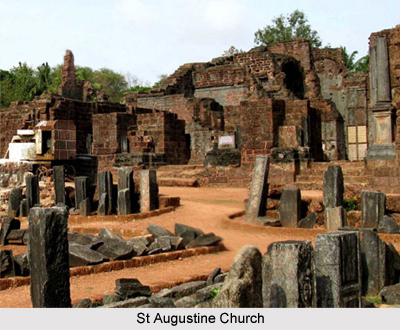 To the south of the chapel is the tower of the Church of St. Augustine, which protrudes out of the bordering greenery, a fuming broken finger of red laterite. Almost 150 ft in height, the tower is four storeyed, with an arch in each. Around the tower lie the ruins of the convent, once distinguished as the loveliest and dignified building in the old city.
To the south of the chapel is the tower of the Church of St. Augustine, which protrudes out of the bordering greenery, a fuming broken finger of red laterite. Almost 150 ft in height, the tower is four storeyed, with an arch in each. Around the tower lie the ruins of the convent, once distinguished as the loveliest and dignified building in the old city.
In current years, the ASI has made several fascinating discoveries here while achieving restitution work. These contain an odd poison plate and exquisite pieces of Chinese pottery of the Ming Dynasty and Caledonian pottery. A Georgian queen is also thought to have been buried in this spot. In 1991, after an official request from the Russian Embassy, there was a search for the last resting place of Queen Katevan, who was said to have been executed by her husband in 1634 for changing over to Christianity.
The Bainguinim Spring must not be neglected at any cost, which is down National Highway 17, towards Panaji, near the group of churches. The spring is on the road bordering the highway, to the left. A path goes up the hill where the road ends. A 20-minute walk brings one to the spring, which cascades round the year and whose waters are ascribed with tremendous therapeutic properties. The Portuguese fulalgos are regarded to have favoured the pure waters of this spring to wine. The fountain is now in a ramshackle state, but its water is still considered salubrious.
It is advised to turn back to the Basilica, towards the Rua Direita, and one will reach a square, currently dominated by a statue of Mahatma Gandhi. This was the main market square of the old city, called the Pelourinho, because it had a pillory where criminals were publicly lashed. The pillory was later repositioned a hundred metres or so south, where it now stands at an intersection of two roads, named without too much originality, Pelourinho Novo or New Pillory. This black basalt pillar with iron rings on an elevated platform once occupied the fundamental place in the city square and was used for public flogging of law-breakers till the 17th century. It was an implement of civil justice - one landed up in the pillory for not paying one`s debts - and not an afflicting instrument of conversion.
The road turning to the right as one faces the pillory (south of the square) reaches the Church and Convent of the Miraculous Cross. This is where the Blessed Jose Vaz, who was beatified of late by Pope John Paul II in Sri Lanka, founded the Oratorian Society, the first parochial order of ethnic Indian priests. On the way is a paved road on the right, a remainder of the 65-ft-wide Raj Bidi or royal road constructed by the Kadamba kings in the 13th century. This extended from their harbour at Gopakapattana (the present village of Goa Velha) to Ela, which afterwards became Old Goa.
The Convent & Church is open to visiting from 9 a.m. - 6 p.m.
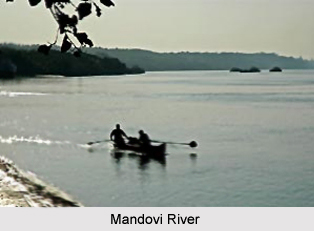 In the northeastern direction of the square, a narrow road leads uphill to the Chapel of Our Lady of the Mount (Nossa Senhora de Monte), furnishing a spectacular view. The road to the chapel cuts off from the road leading from Old Goa to Daujim and Gaundalim, which sinuates its way up the hill. Leading up to the chapel is a flight of charming laterite stone steps. One earns an enthralling view of the whole of Old Goa churches and Mandovi River from outside the chapel. The church was built in 1510, soon after the subjugation of Old Goa.
In the northeastern direction of the square, a narrow road leads uphill to the Chapel of Our Lady of the Mount (Nossa Senhora de Monte), furnishing a spectacular view. The road to the chapel cuts off from the road leading from Old Goa to Daujim and Gaundalim, which sinuates its way up the hill. Leading up to the chapel is a flight of charming laterite stone steps. One earns an enthralling view of the whole of Old Goa churches and Mandovi River from outside the chapel. The church was built in 1510, soon after the subjugation of Old Goa.
The chapel visiting timings are from 9 a.m. - 6 p.m.
Coming back to National Highway 4 and on the road to Ponda, one will notice a stately structure on the left. This was the entryway to the eminent College of St. Paul. Down the mud road are the Chapel of St. Francis Xavier and the well where he washed his feet closeby. Only the gate and some relics remain of the college of St. Paul, which rose to distinction under St. Francis Xavier during the mid-16th century. It is alleged that the college was erected atop the ruins of a mosque, which was dismantled. Now, through a bizarre twist of destiny, the dargah of a Muslim pir stands here.
The Chapel of St. Francis Xavier is constructed on the spot where Afonso de Albuquerque orchestrated the battle against Adil Shah`s soldiery to conquer the city and is one of the oldest outliving churches in Goa (though the Chapel of St. Catherine and Church of St Francis de Assisi precede it, yet both were reconstructed afterwards). The square, the three-storeyed portico with cylindrical towers in every corner gives it the visual aspect of a fortified church. Of distinction in the interior is the marble cenotaph of Dona Catarina de Sa (blue-collar wife of one of the viceroys, as speaks the inscription), which has elaborate carvings in Bijapuri style, while a vase possesses foliation and other ornamentations strongly resonant of those seen on Gujarati tombs.



















